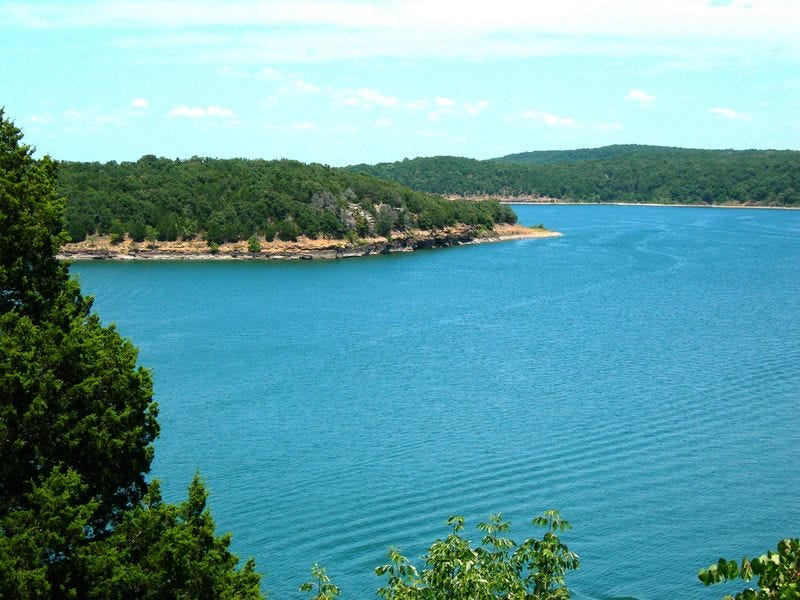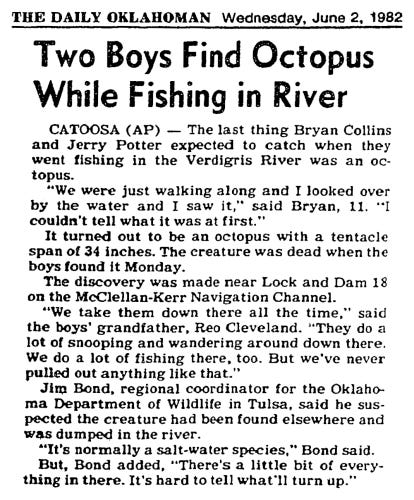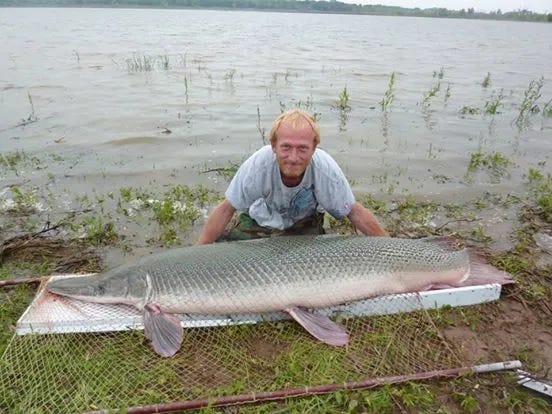Everyone has a fish story, something they break out at parties when there’s a lull in the conversation. They get told time and time again, and with each retelling grow a little further from the truth. Your cousin probably didn’t play skee ball with Keanu Reeves at a Dave and Buster’s in LA, but it sounds like the kind of thing that could have happened. That plausibility is the key to any great fish story.
The Lost Tapes
It must have been around ten years ago that I first heard about the Oklahoma Octopus. A video (that I’m surprised to find is still up) came across my YouTube page proclaiming, “Every year, there are more unexplained drownings in Oklahoma. Local legend says they're victims of the Oklahoma Octopus.” I was still living in Oklahoma at the time, and I think the number one comment on that video sums up my feelings.
The video was uploaded by, of all channels, Animal Planet. And you might be thinking, “But Gary? Isn’t Animal Planet a trustworthy source of nature documentaries?” To which I would say, sure, in like, 2005. But over the last decade they’ve fallen into the predatory world of “reality” television, including three seasons of perhaps the most egregiously awful show ever: The Lost Tapes. Much like Ghost Hunters or MonsterQuest, Lost Tapes was a “paranormal reality show,” that cashed in on the mid-aughts love of all things spooky. After all, this was the decade that gave birth to both Zak Bagans and Slenderman — but those are monsters for another day.
Lost Tapes was essentially a found footage anthology series. It would have been right at home on the SyFy channel. Each episode featured a different cryptid, from the Chupacabra to Mothman. They even showcased a few of the monsters I’ve covered in the series, like The Dover Demon and The Beast of Bray Road. The basic formula looked like this:
Step 1: Put some eerie music over unsourced text attributing “unknown deaths” to rumors of a monster in the area.
Step 2: Lay down some vaguely menacing B-roll with a voiceover (again unsourced) claiming that it’s possible a monster like this might exist.
Step 3: Cut to “found footage” of a hiker/biker/swimmer/security guard/drunk teenager in the area talking about how they “don’t believe in the monster.”
Step 4: Intercut the footage with real people talking about how the monster “has been reported for years.” Make sure to quote vague ‘Native American legends’ to lend it an air of credibility.
Step 5: Profit.
Every episode featured a fictional story about someone that was “attacked” by these monsters — usually fatally. I mean, at least shows like MonsterQuest had the decency to call their videos “reenactments”. The Lost Tapes just straight up wrote a short horror film. Here’s the summary for the episode on the Oklahoma Octopus:
“Following their high school graduation, Sean Conklin, Tracy Miller, Tyler Shuman, Bruce Delroy, and Ruthie Semple decide to spend their last weekend together at a local lake. Upon arriving however, Conklin sees several large tentacles splashing in the water, but no one else sees it and dismisses him. After Shuman finds a canoe, the group heads out to a floating platform. As the day progresses, Shuman pulls several pranks on his friends. They scold him, but he gets upset and leaves with the canoe. Conklin assures his friends that Shuman will return, but they hear him scream and see that the canoe has been capsized. Despite the others assuming it is another prank, Delroy attempts to find Shuman, but something pulls him underwater. The remaining three yell for help until night falls, but what appears to be a giant octopus grabs Semple and pulls her off the platform. Seeing no other choice, Conklin and Miller attempt to swim to shore. They are later found alive and treated for exhaustion, shock, and unidentified blister-like wounds, while their friends' bodies are never found.”
Making a Monster
I don’t think the show ever actually fooled anyone into believing these stories were real. But they did contribute to the lore of the creatures they covered, or in this case, they might have essentially created it. The episode premiered In January, 2009, and if we look at the Google search trends we can see the exact moment it dropped.

Not a single person Googled the phrase “Oklahoma Octopus” before January ‘09. Now I’m not saying correlation equals causation, but the same month the Lost Tapes episode came out, searches spiked 100 percent. If you were to search for the phrase now, you’d find a number of websites that describe the Oklahoma Octopus as though it has always existed in the pantheon of famous cryptids, right up there with Bigfoot and the Loch Ness Monster. Nearly all of them rip the language right from the episode, describing the creature as “the size of a horse…with reddish, brown skin and tentacles.” You can find the language here, here, here, and here. I don’t think these authors realized this description was coming from the episode, most likely this is an example of the language being cannibalized over time, quoted and requoted until it lost attribution. These sources also attribute the monster to three specific lakes in Oklahoma: Lake Thunderbird, Lake Oolagah, and Lake Tenkiller. Additionally, they reference “Native American legends” that are “over 200 years old" which refer to the creature. Though none of them name the specific tribal nation that these legends supposedly originate with.
In 2023, Rachel Hopkin, an NPR reporter, radio host, and folklorist, wrote an expose on the Oklahoma Octopus. I highly recommend you go check out her whole series on KGOU, How Curious, it’s a masterclass. Meanwhile, you can listen to the episode embedded below.
For the TL;DR, Hopkin didn’t uncover a single reported sighting of the octopus.
So, this leaves us with a pretty big question: Did Animal Planet make up a cryptid?
Well, yes…and no.

Tracking Down the Truth
Like any great fish story, the Oklahoma Octopus has been exaggerated to the point of parody. If you listened to Hopkin’s story, you’ll already know that she uncovered a reference to the creature from before the Lost Tapes episode. A single entry from a 2007 book: Monster Spotter’s Guide to North America. She even reached out to the author, Scott Francis, though didn’t hear anything back. I was able to grab a copy of the book on Kindle and the entry feels…familiar. The full text is below:
“Lakes in Oklahoma rate high in instances of drowning. Some believe that drowning victims actually fall prey to the giant octopi living in the lakes. Several of Oklahoma’s lakes, including Lake Thunderbird, Lake Oolagah, and Lake Tenkiller, are said to be home to these monstrous creatures that are thought to be responsible for dragging swimmers and fisherman to their watery deaths.”

That’s it. That’s the whole entry. It seems like the producers for The Lost Tapes pretty much just took Francis’s words verbatim. Though Francis never referred to the creature as the “Oklahoma Octopus.”
Rod Lott, a journalist for the Oklahoma Gazette (RIP to the state’s best alt-weekly) set out to test Francis’s claim that “some believe” the octopus was responsible for drownings in the state. Unfortunately, since the Gazette is now defunct, the full story is no longer available. However, I was able to recover a partial story thanks to our friends at the Internet Archive. Lott quotes two park managers who denied having ever heard about the creature.
“"Not out here. And I've been here for 27 years," said Susan Hendon, manager of Lake Thunderbird State Park. "No one has ever (mentioned that) " I swim in this lake every weekend, I'm here, I live here. Nothing."
At Lake Tenkiller in Vian, park manager Steve Williams said the killer octopus is news to him.
"I've never heard of that," he said. "Nothing to my knowledge. You can hear just about anything at any time."“
Okay. So Francis created the creature. Case closed.
Well…
This is an entry from, and I’m not making this up, A wizard's bestiary : a menagerie of myth, magic, and mystery. The book was written by Oberon Zell-Ravenheart, a man who deserves his own deep dive. I mean, look at this guy. Honestly, he can create all the cryptids he wants.
Oberon’s book came out six months before Francis’s. It’s all there. The lakes. The description. The native legends. Is it possible Francis got his hands on Oberon’s book before his own hit shelves, and then worked the octopus in to fill space? Maybe. That would make the bestiary the actual origin point for the Oklahoma Octopus. And it’s a theory which contains that sense of plausibility every great fish story needs. My search could have ended right here, and I would have been comfortable in my conclusion that Oberon’s Oklahoma Octopus was the start of it all.
But something wasn’t sitting right. I’m pretty familiar with the publishing process, and I know how staggered these workflows tend to be. The likelihood that Francis copied Oberon’s homework just a few months before his book hit shelves is pretty slim. The spotter’s guide would have been in the final stages of production, with prints already settled, by the time the bestiary was available. And if that was the case, what was the probability that both Francis and Oberon made up the same monster? Next to none. So the story had to have roots in an even earlier tale. But where?
Thankfully, other researchers have been on the case. Earlier this year, Tyler Greenfield over at Incertae Sedis (Latin for uncertain placement) published a blog about the Oklahoma Octopus. Uncovering this post has been a revelation. Greenfield discovered an even earlier reference to the creature. The post is from a Japanese blog about cryptids, of all things. Once again it’s all there: the color, the size, the lakes, even the name. It’s dated June ‘06, months before either book hit shelves, and a full three years before the Lost Tapes episode.
Additionally, Greenfield’s post cites the full article from the Gazette (the one that is no longer available) which includes a quote from Loren Coleman, in case you were wondering when our favorite Cryptozoologist was going to pop up in this episode. According to the post, Coleman “proposed that the stories began with carcasses dumped as pranks”. Sure enough, Greenfield was also able to dig up an article from The Oklahoman that corroborates Coleman’s theory.

An actual octopus (well, the corpse of one) was pulled out of a body of water in Oklahoma. The water in question, the Verdigris River, is within a few miles of two of the three lakes typically cited as the creature’s home. The octopus wasn’t the size of a horse, but it certainly seems like Greenfield had finally drilled down to this story’s bedrock. As he surmised, the legend of the Oklahoma Octopus likely originated right here, with this literal fish story.
….
Yeah, there’s another twist coming.
Legends of the Kiowa
Greenfield also mentioned another article, written by Russell Bates, that was published in a 1987 issue of the INFO Journal — just five years after the discovery of the octopus in the Verdigris River. Bates was a member of the Kiowa Tribe who lived in Anadarko, OK (Darko to the locals). He was born in Lawton, the same city I worked as a journalist in for over five years. Bates was also a writer who penned dozens of short stories and even an episode of Star Trek: The Animated Series. Not just any episode, actually, but the first episode of any Star War series to win an Emmy. Sadly, he passed away in 2018.
Bates’ article, titled Legends of the Kiowa, includes a lot of stories from his people, as well as a few other tribal stories he’d heard growing up. One in particular stands out, and, well, I’ll let you read it:
““In the matter of other water creatures, I have only heard that the Caddo people once camped near small lakes that spring literally out of sandstone cliffs some ten miles north of here. This would have been some two hundred or more years ago. They would never let their women go for water without being accompanied by an armed man because something lived in those lakes that would snare and drag a human deep underwater into caverns carved by the springs. What little I know of them is that they are about the size of a horse, have several arms or tentacles and very tiny eyes. Oddly, they are reddish-brown, look leathery, and make no sound at all, much like some kind of snail or slug that has no shell … Oklahoma at last began to receive man-made lakes in the late 1950s and through the ‘60s. Unexplainably high drowning rates exist at Tenkiller Lake, Lake Thunderbird, and Lake Oolagah. I know this as well: you could not get me to either fish or to go swimming in those lakes if you offered me gold.””
— Russell Bates, 1987
The size of a horse? Check. Reddish-brown and leathery? Check. Lake Tenkiller, Lake Thunderbird, and Lake Oolagah? Check. Two-hundred-year-old Native American story? Check.
Russell Bates wrote the first available description of the Oklahoma Octopus.
Do I believe?
Greenfield dismissed this article as “inspired” by the ‘82 octopus discovery. He also concluded that because Bates was Kiowa, and not Caddo, and because he himself couldn’t find the story anywhere else, that it should be considered apocryphal. Here is where I will diverge from Greenfield’s theory. While I appreciate the work he did to uncover these two articles, I find his conclusion a little too dismissive.
Anyone who grew up, as I did, in Oklahoma, knows that Indigenous stories are told orally far more often than they are actually written down. This might be the only written example we have of this particular story because Bates, as a writer, was the only one to commit it to the page. It seems this is one of those rare moments when that old cliche of “Native American legends” actually has some truth to it, backed up by the lived experience of an Indigenous man local to the area.
So, yes, I believe Bates. But, does that mean I believe in the Oklahoma Octopus?
No.
I don’t think I really need to explain this one. As Bates mentioned, all of the lakes this creature is supposed to inhabit were manmade in the mid-19th century (nearly every lake in the state is manmade). And as just about any marine biologist will tell you, Octopi just aren’t adapted to survive in freshwater.
““Freshwater dwellers have salty blood relative to the water around them. Without a mechanism in place to control it, osmosis would equalise salt concentrations between the animal and the water surrounding it, pumping salt out of the body and flooding it with freshwater,” according to the Head of Science at Museum Victoria, Dr Mark Norman. "While we can't be 100 percent certain, it's unlikely that there have ever been freshwater cephalopods."'“
But of course, it’s possible that, given enough time, a subspecies of octopi could adapt to live in freshwater. And it seems like there was, at some point, something ominous lurking beneath the muddy waters of my home state. There’s just enough probability there to make for one hell of a great fish story. Still, when it comes to Oklahoma’s lakes, I wouldn’t worry about an Octopus attack.
The Alligator Gar on the other hand? Well, that’s a different story.

Woof! That was a long one! So, what do you think? Is there any truth to the Oklahoma Octopus? Let me know in the comments!
Hey! If you’ve been enjoying Monster of the Week, could you do me a favor? Click the share button below, you’ll have my eternal gratitude.
Thanks for reading Monster of the Week, which is released every Tuesday (unless it isn’t) and features stories of the paranormal, the unknown, and other high strangeness. If you’d like to support me, please consider subscribing — it’s free. Also, I’m on Twitter now (yes, the most monstrous of social platforms, how fitting). Give me a follow @MonsterAweek. Also, don’t forget to subscribe!









This story cites some interesting accounts, but I think the deal breaker for this legend is that almost all the lakes in OK are man made through damming. The only connection OK has to the ocean that I can think where some sea creature could get into a lake there would be to swim all the way up the Mississippi river to the Arkansas tributary. I'm not sure how it would get into a lake from there. Maybe it could be some prehistoric species leftover from when OK used to be underwater millions of years ago, but that's a BIG stretch. Then again, it could always be ALIENS (I'm not saying it was aliens...but it was ALIENS!) .
Wonderful detective work, Gary. Love this story and your analysis. Will share with my "monster" friends.